Archive for ‘NAPO Conference’ Category
NAPO 2015 Expo: Magically Organize Your Writing with the Equil® Smartpen 2
We professional organizers are pretty easy to intrigue, but hard to impress. We like novelty, and you can hear our oooohs and aahhhs across the ballroom floor at the NAPO Organizing Conference and Expo when a vendor lengthens a folder tab, come out with a poly version of a product formerly only available in paper, or builds a better hanging folder.
But as much as we appreciate novelty, we’re quick to note shortcomings as well. We’re dismissive of features we can’t see our clients actually needing, and we’re dubious of also-rans — the third or fourth or fifth practically identical copy of a product or app that doesn’t improve upon the original.
One of the products that caught Paper Doll‘s eye, and kept it focused, at this year’s Expo is a hybrid, bringing two separate but related processes together. In the past, we’ve focused on paper hybrid office products:
- An Organized Hybrid: The Evernote Smart Notebook By Moleskine
- From Paper to the Cloud: Ampad Shot Note
- It’s a Notebook! It’s a Whiteboard!: 3 Dry-Erase Notebook Innovations
In the above cases, we’ve looked at notebooks and notepads that work two ways. But what about a writing implement that can do double-duty?
Equil® SMARTPEN 2
Friend of the blog, Smead, is known primarily for paper-related office products (e.g., folders, organizers, dividers, folios, etc.), and we’ll get to the newest of them in an upcoming post. But recently, Smead has been acquiring interesting and useful tech and tech-ish products, like the MOS: Magnetic Organization System for cable and cord organizing, Stick N Find bluetooth trackers, and MOS Spring Cables for strong, tangle-free syncing, charging and playing audio.
The Equil® SMARTPEN 2 is the latest innovative acquisition, and it’s a doozy. What does it do? The SMARTPEN 2 lets you:
- Create handwritten notes, sketches and diagrams on real paper (whether that’s a fancy Moleskine or a cocktail napkin). But it can also be used as a stylus to write and draw on your iPad, which the company claims it does with superior accuracy. (Paper Doll‘s drawing skills would be a poor test of this acuity, I assure you.)
- Capture writing and doodlings and digitally transfer them to Windows, Mac, iOS and Android devices without scanning or snapping photos.
- Save, modify and share the digital version of your notes (so you’ve got the original paper version, suitable for framing on your wall or locking in your safe deposit box, and the digital — even modified — version in the cloud or on your devices.
- Oh, and that modification? It includes the ability to convert your handwriting into readable, searchable, editable printed text.
- Share via email, Facebook, Twitter, and other social media, or upload to the cloud for saving and sharing to Evernote, Dropbox and iCloud.
- Whatever you create with the Equil® SMARTPEN 2 syncs across all of your devices, so wherever you are, you’ll be able to create anew or access what you’ve already written.
THE BASIC ELEMENTS
The Equil® SMARTPEN 2 looks like an Apple product. It’s all white-on-white, and comes packaged in a streamlined charging cradle, a triangular base into which the two operational parts snap, and the case comes with a grey “wrap” (called a convenience case) similar to the iPad Smart Cover.
The Pen — This is a technology-“enabled” pen. That means it’s a real pen, on its own, and uses regular ballpoint ink cartridges. It’s pressure-sensitive, so it can capture every nuance of what you draw, and if you press heavily (and perhaps repeatedly), with insistence, the pen knows you’re doing the equivalent of bolding your text and SHOUTING with intensity.
In order to save the battery life, the pen goes to sleep if you don’t write for a while. One press of the small button atop the pen wakes it up, and that same button functions to alert the receiver to a “new page” (creating page breaks) and to let you go back and forth between saved pages of notes.
The charging cable includes one replacement ink cartridge.
The Receiver — At first glance, the 3″ W x 1/2″ H receiver device looks like a clip for a clipboard, and it fastens to the top of your notepad or paper in a similar manner. The pen and the receiver connect via magic (OK, infrared and radio frequency communication). The receiver determines the boundaries of the page and flashes a small red light to alert you when you’re getting too close to the top or the bottom edge of what it can detect.
As you write with the pen, the receiver device saves your notes in the built-in memory.
The receiver holds 10,000 pages of notes. When you reconnect your pen to your digital device, you automatically receive an alert about any new notes, which are ready to be imported.
You can digitize your notes in real time, but it doesn’t matter if you’re not connected to your phone or other device when you’re in creation mode. When you are ready, at the touch of the button on the top of the receiver, whatever you’ve created can be uploaded from the device and imported to your computer, phone, or tablet. (Not your fancy watch, though. At least, not yet.)
The pen and receiver are rechargeable, and the specs claim you can write or draw for eight hours between charges. Just pop both the pen and receiver into the USB-compatible charging cradle. (The receiver has a battery life indicator and a charging indicator, so you shouldn’t have any surprises.)
The SMARTPEN works with two free apps:
Equil Note — This app lets you save and organize any of the written notes you take with the SMARTPEN 2. Edit, enhance, and share them with friends and colleagues. Convert your handwriting to text for easy editing and sharing.
Equil Note has apps for iPhone, iPad, and Android mobile devices, as well as Mac and Windows for desktop use. It’s available in English, French, Spanish, German, Italian, Portuguese, Russian, Chinese (Simplified and Traditional), Japanese, and Korean.
Equil Sketch — The sketch app lets you draw with a finer degree of control, and includes digital options like multiple brush styles and layering. You can start a picture on paper, and finesse it on the screen.
Through the apps, you can digitally choose from a variety of colors and pen tips, and up to 600 levels of pressure sensitivity, and then add more text and/or photos, digitally. You can also tag your notes so you can search and locate your content quickly.
The Equil Sketch app is only available for iPhone, iPad and Android digital devices (not desktop), and is compatible with all of the same languages as Equil Note, except for Korean, Portuguese, and Russian.
PRICE
The Equil® SMARTPEN 2 retails for $169.95 from the Equil shop, or for about $149 from Amazon, Apple and Best Buy. Access to the apps is free with a purchase of the pen.
THE FINE PRINT
There’s glossy marketing, and then there’s the occasional factual balloon pop.
Although the press materials reference doodling on a napkin, and the pen can capture notes on paper as small as a sticky note, the official specs say that the recommended paper size is 250mm x 330mm (9.85″ x 13″) or smaller — that’s anything below Letter size (US standard) or A4 (UK standard) — and notes that things “may not work properly if the paper is too small for the receiver to clip on and may have writing recognition issues if the paper surface is rough. (i.e., cardboard).“ So, don’t plan to write on something the size of a postage stamp or your next summer camp care package.
Next, the Equil® SMARTPEN 2 communicates to your digital devices through bluetooth pairing — if you’ve ever used a bluetooth headset for your phone or a keyboard for your iPad, you know to prepare for some set-up time before you can get started. One note I found in the FAQ caused a slight pause: “Make sure to go through bluetooth pairing process each time you switch the devices you are using with Equil JOT.” It’s not entirely clear whether this means you have to pair the pen each time you switch from your tablet to your phone, or just the first time for each. FYI.
Finally, the SMARTPEN 2 measures 1/2″ around the thickest part of its triangular shape, slightly thicker than a traditional Sharpie. It tapers down as you get closer to the pressure-sensitive pen-tip. Still, if you’re used to a slender, rounded pen, the grip of this might take some practice for creating fine detail.
Take a look at the Equil® SMARTPEN 2 in action.
THE COMPETITION
The Equil® SMARTPEN 2 isn’t the first to combine writing on paper with writing on a digital device and making it all interactive. (Even the SMARTPEN 1, the first iteration, wasn’t exactly first.) The Livescribe Smart Pen series (including the newest Livescribe 3, the Sky WiFi, and Echo, and older iterations) was the first to break out in this area, and for many years, I would gush when techie colleagues would show off their Livescribes. The Livescribe pens also had an embedded audio recorder, so you could tap a portion of your notes to hear what was being said contemporaneously with whatever you wrote. Pretty grand!
But the SMARTPEN 2 continues to have one advantage over the various Livescribe versions that can’t be overlooked. You can use the Equil® SMARTPEN 2 with pretty much any type of paper or notebook, so you can stick to your preferred notebook style, but after all these years, the Livescribe options still require that you buy special digital paper notepads to work. Paper Doll doesn’t know about you, but while I’m occasionally willing to shell out for a truly exceptional gadget, having to buy pricey notepads just so the pen can work is a deal-breaker for me.
WHO IS IT FOR?
Obviously, not everyone needs a smart pen. If you’re fine with keeping handwritten notes and rarely need information in digital form, you can pass. If you spend your time sitting at a desk, fully Wi-Fi-enabled, or are good with the “thumby” thing, typing without a real keyboard, even when standing or walking, it may not be for you. The SMARTPEN 2 is ideal, however, for those who are on-the-go, often standing, or in rough-and-tumble surroundings. I’m thinking of my client who is usually up in a bucket truck, using his iPad to take notes but risking damage to his expensive gadget. Or camp counselors checking kids in for the summer and taking notes of parents’ special requests. Engineers and architects, working on-site. Community physicians and nurses who don’t have immediate access to electronic medical records and are taking notes on-the-fly.
With the handwriting recognition feature, particularly the ability to turn handwriting into text, and the ability to use regular paper, the Equil® SMARTPEN 2 is worth some attention.
I’d love to hear your thoughts.
NAPO 2015: Origami & SOFI–Innovations for Organizing Your Home
People ask professional organizers about storage solutions all the time. What are the best containers for our possessions? What shelves or tubs or drawers or dividers or other magical tools should we buy to organize our stuff? Of course, that’s the wrong question, or at least the wrong first question. To me, focusing on the storage container instead of the contents is like buying an outfit and becoming determined to lose weight to fit into it.
The problem? When we set out to lose weight, we really have little idea (or control over) whether the weight lost will be in the bosom or the buttocks, the abs or the love handles. It makes much more sense to reduce the excess (of our stuff or our too, too solid flesh) before picking the perfect outfit, wrapper or container.
That said, the right storage container, in a pleasing style or color, can help us preserve order and keep us from backsliding into clutter. Today, we’ll explore two new product lines that displayed their storage solutions at the NAPO 2015 Annual Conference and Organizing Expo.
ORIGAMI
EXPO attendees were mesmerized at the Origami booth. As you may know, origami is the Japanese art of paper folding, an art with which I’ve had mixed results.
Think about what you detest most about putting shelves and racks together. The difficulty making sense of poorly translated directions? The need to buy weird one-time-use tools? The extra bits and pieces left over, leaving you fearing the whole thing will collapse?
Origami seeks to put those worries out of our heads by creating racks and shelves that are already fully assembled, folded and collapsed prior to packing, and require only a bit of “unfolding” to display their genius. No tools are required, and most of the products fold flat for easy storage.
To see how a basic Origami Rack comes together, take a peek at this video.
Origami has five product lines:
- Home Origami products includes racks, tables and organizers. The racks are suitable for mudrooms, bedrooms, pantries and living rooms, and also include decorative displays, folding closets and shoe racks.
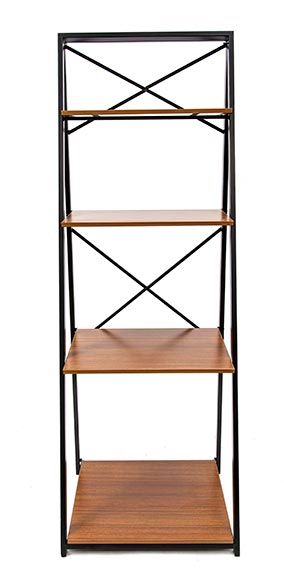 The basic table is just the right size for sewing, crafts or a small study desk. The metal/soft-side organizers work vertically and horizontally.
The basic table is just the right size for sewing, crafts or a small study desk. The metal/soft-side organizers work vertically and horizontally.
- Kitchen Origami products include a tall pantry rack, Baker’s rack, and a variety of kitchen carts.
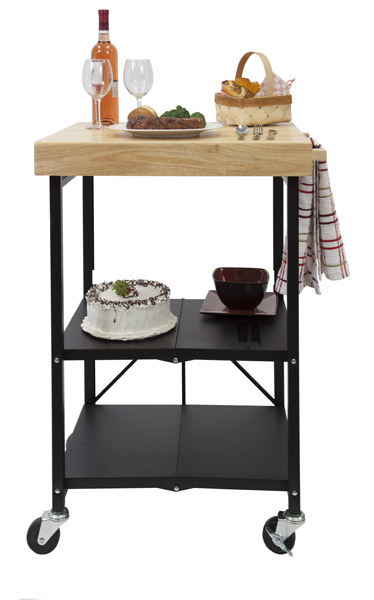
- Garage Origami racks come in multiple sizes, shapes and heights, and both with and without wheels, for everything from storeroom displays to corralling seasonal possessions.
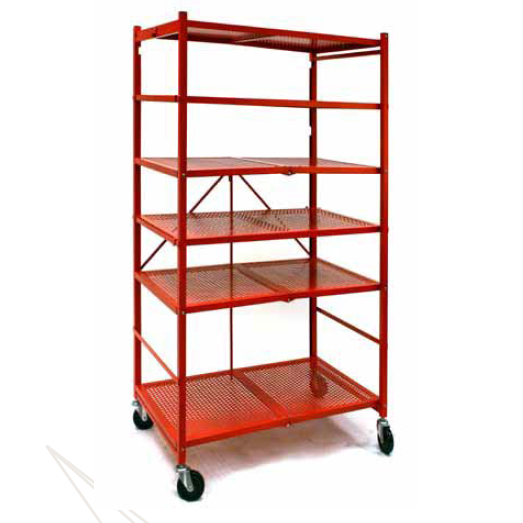 There are also small and full-size workbenches.
There are also small and full-size workbenches. - Garden Origami products include a 3-foot potting bench and a 4-tier greenhouse.
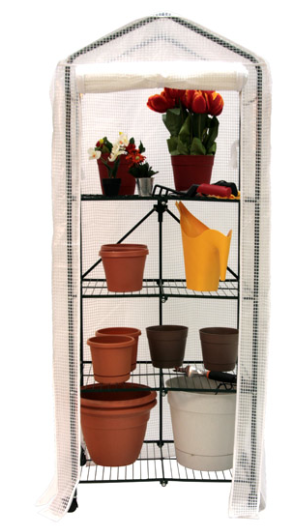
- Office Origami items include a six-tier bookshelf, a standard computer desk and a laptop trolley, as well as an intriguing folding trunk.
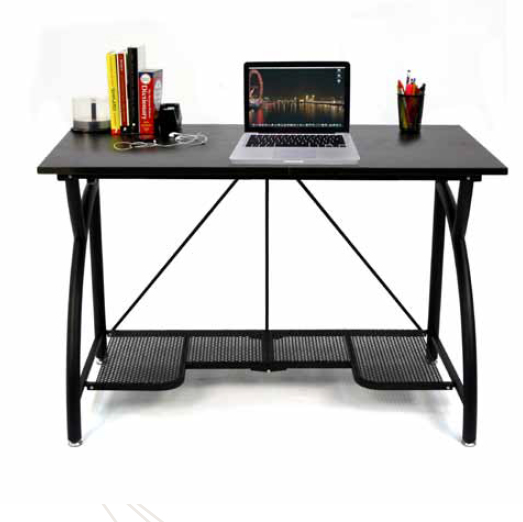
Other products, not shown on the Origami web site but included in the catalog distributed at the NAPO Expo, include an over-the-washer/dryer rack, additional general-purpose shelving units and bookshelves, a TV stand with extra tiers, and soft canvas rack and cart covers.
The Origami racks and other shelving items seemed impressively sturdy and easy to “unfold” into place; most of the shelves for the larger racks have a 250 pound weight-bearing capacity. (The pantry rack, computer desk and workbenches support 100 pounds; the laptop trolley, 50 pounds.)
Pricing for the various units ranges from $49.99 to $299.99, though the vast majority of items are under $150. Origami’s shelves, racks, tables and organizers are so new that there’s no distribution information readily available on the website, but if you’re willing to have something shipped, you may purchase through the Origami web site at each individual product page, or visit Amazon to purchase a small sub-set of Origami racks.
SOFI
SOFI™ is a new product from an old friend. You’re almost assuredly familiar with Bankers Boxes, made by Fellowes, either from personal use at home or work, or via This Is Not Your Grandfather’s Bankers Box. We’ve talked previously about the advances in Bankers Boxes in recent years, but this is something brand new — a mix-and-match storage organization system.
Each item this line is stain-guard protected, with a silk-textured exterior and a patterned (SOFI materials say “stylish,” but that’s subjective) interior. All of the items below, with the exception of the HEX boxes, have strong woven handles with brass rivets. All but the Hex Boxes boxes and STAX shelves are made of up to 80% recycled content.
The SOFI elements, from smallest to largest, are:
Hex Box™ — These hexagonal open-top containers measure 4″ H x 5″ W x 4.25″ D and are designed to organize small items in the open, on shelves, nightstands, or dressers, or for organizing the interior of easily cluttered drawers and cabinets. SOFI Hex Boxes come two to a package, and you can use the enclosed clips to create a sort of honeycombed organizing system by fastening two or more HEX Boxes together.
Zipper Tote™ — This cube-style tote comes in two sizes, Small (10″ H x 10.75″ W x 10.75″ D) and Tall (13″ H x 10.75″ W x 10.75″ D), and the vertical intersections of the front (handled) panel with the flanking panels zips down to provide easy access to contents.
Rax Bin™ — Angled sides of this open-top bin allow both easy access and a full view of the contents, making it suitable for wallets, purses, totes and other items you would stack vertically. It measures 10″ H x 15″ W x 13″ D.
Brix Bin™ — Envisioned for bulkier items like linens, toys and chunky accessories, this bin measures 10″ H x 15.5″ W x 10.75″ D.
Brix Box™ — Like the Zipper Tote, this cube-style tote comes in two sizes, Small (10″ H x 10.75″ W x 10.75″ D) and Tall (13″ H x 10.75″ W x 10.75″ D, as shown below), but lacks the zip-down panel.
The smaller Brix Box™ is compatible with the Stax Shelf, below.
Stax Shelf™ — Designed to help make the most of vertical space by allowing stacking, this mini-cupboard allows you to stack two of the small Brix Boxes vertically; multiple Stax Shelves could be put together horizontally or vertically (with the enclosed connecting clips) to create an organized system of stackable (small) Brix Boxes. You may also use the shelf on its own, without internal boxes. 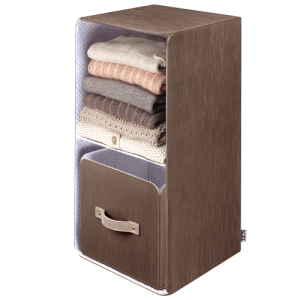 The central shelf has a 15 pound capacity; the unit measures 24″ H x 12″ W x 12″ D.
The central shelf has a 15 pound capacity; the unit measures 24″ H x 12″ W x 12″ D.
SOFI products seemed sturdy enough, from the cursory glance I got at the crowded NAPO Expo. However, if you have roughhousing tiny humans (or pets) intent on putting these storage items through their paces, you might want to add pieces slowly and review how your more wackadoodle household members deal with them.
The main drawback I see with SOFI, and this is certainly subjective, is that the line currently comes in a very drab, manly, retro brown, recalling the panelling in my parents’ 1970s living room, and the interior blue and white pattern doesn’t provoke much fashionista excitement, either. SOFI’s tag line is “So functional. So fashionable.” I’d agree to the former, but am unpersuaded as to the latter.
SOFI products are sold at Amazon, Staples, Office Depot, Wal-Mart and Target, and other retailers, with prices ranging from $10-$30.
Check out the video of SOFI in action.
Origami and SOFI were just two household organizing products to make their debut at this year’s NAPO Expo. Later in this recap series, we’ll revisit some old favorites to see what new tricks they had on display. Until then, make sure you haven’t missed some of the prior posts in this series:
NAPO 2015: Conference By the (Organizing) Books
NAPO 2015: PhD in Productivity at the College of Organizing Knowledge
NEET & Cozy Cables: A NAPO 2015 EXPO Organizers’ Choice Award Winner
NEET & Cozy Cables: A NAPO 2015 EXPO Organizers’ Choice Award Winner
Everybody complains about cable storage. You can’t swing a lightning cable without hitting a blog post or video or Pinterest page on keeping cables untangled, separated, and safe, whether via retail products or DIY methods. For example:
- Paper Doll’s Cable Conundrums & the MOS: Magnetic Organization System
- Organizing the Cords Under Your Desk! by Helena Alkhas
- Cords and Cables and Labels and Controlling the Cables: 3 Novel Solutions by Jeri Dansky
- 10 Ways To Get Cables Under Control by Gina Trapani
- Organize, Store and Buy Computer Cables Wisely by David Caolo for Unclutterer
- How To Tame Cable Cord Chaos (video) by Lori Marrero
- Untangle Your Life: Living Organized With Cables and Cords by Apartment Therapy
- 61 Clever Cord Organizers
However, most of the standard stabs at keeping cables and cords organized seem to focus on cables that stay put in your home or office. Other than Paper Doll-recommended Grid-It!, a past NAPO EXPO fan favorite, we rarely see much about how to corral cables in transit so they don’t get tangled in our book bags, purses and when we’re on the go. Happily, the NAPO 2015 Annual Conference and Organizing EXPO had an exciting new entry in the world of cable organization.
NEET Cable Keeper
(©2015 Julie Bestry. Peter Chin, founder of NEET Products.)
Winner of the 2015 Organizers’ Choice Award, the NEET Cable Keeper is the equivalent of a tea cozy for your cables, if your tea cozy were crossed with a hoodie crossed with a corset. Each long, colorful strip of cloth material — NEET calls it a “shell” — isolates a single cord or cable from any other, and then includes these essential features:
Zipper — Here’s where the hoodie action comes in. There’s no threading your cable or cord through a complicated maze of plastic molding. (If you’ve ever tried to replace a drawstring in a pair of sweatpants, you know how frustrating that can be. Yes, you can attach a safety pin to guide the string, inch by inch, but ARGGGGGHHH, just recalling that makes Paper Doll grumpy.) Merely lay the cord or cable down across the NEET Cable Keeper and zip it up!
The bottom of the shell is flared, which allows you to encase larger USB ends, and it has ample space for multiple cables to be enclosed.
Structured Wire — Sewn into the length of the cloth strip is a bendable wire, much like the stays in a (modern) corset, that provide support stiffness and support. The structured wire services two purposes:
- It protects your cables and cords from damage. There’s no chance you’ll repeatedly fold your cord so tightly that the plastic coating will wear away, or accidentally crush it in a slammed filing cabinet drawer, damaging the delicate internal wires.
- It provides support for the whole cable or cord, making it suitable for wrapping neatly around your wrist as a bracelet, turning it into a loose necklace, or otherwise, bendy, gooseneck-lamp-style, making it beautiful as well as useful. NEET’s website even shows how to bend it into a stand for a smartphone.
Colorful Wardrobe — The NEET Cable Keeper comes in a variety of colors, so you can tell at a glance from across the room whether the cable you’re spotting is your Kindle charger or your Apple Lightning cord. The NEET Cable Keepers come in black, blue, gold, green, light blue, pink, red, purple, silver, white and yellow.
After you zip your cable cozily into the NEET Cable Keeper, like a toddler into a snow-suit, you’re set. It becomes part of the cable itself, so you have no additional pieces to carry or potentially lose; there’s no reason to take it off, unless you’re one of those people who likes to change the colors of your accessories on a daily basis. (Really, stop that.)
Take a peek:
You can get the Keeper two ways, both designed for mobile device cables measuring 3 feet (or about 100cm) or longer and 1/4″ in diameter. If your cable is longer than 3 feet, the width of the Keeper will accommodate you gently folding it before zipping it up.
- NEET Cable Keeper M, with just the Keeper, is $12.
- NEET Cable Keeper M with either a Micro USB cable or an Apple Lightning cable is $18.
It’s available directly from the NEET, and via Amazon, The Grommet and a few other retailers.
Although they are not yet available for purchase, NEET is developing a line of cable organizers for ear buds, laptops, home entertainment, and professional use such as for DJ’s and audio/visual work.
If you own a business and think it would be cool to brand these NEET Cable Keepers for your own customers, NEET founder Peter Chin says, “The NEET Cable Keeper is customizable! We can customize NEET for you to promote your company, event, and brand. Great for corporate giveaways, employee retention programs and brand awareness. Send us a message and we will gladly connect you to our authorized customization partners.”
Zip, wind and organize. Neat (I mean, NEET), eh?
NAPO 2015: PhD in Productivity at the College of Organizing Knowledge
You really have to have passion for your profession to be willing to spend the better part of a week, not only away from home, but many time zones away, packed into conference rooms from morning until night, in order to learn more about the techniques, strategies and products that will help you help your clients and strengthen your business. Such is the reason professional organizers traveled from across the country and around the globe for the 2015 National Association of Professional Organizers Annual Conference and Organizing Expo.
My conference experience started early with the the Board of Certification for Professional Organizer’s (BCPO®) annual, all-day, in-person Board of Directors meeting. Pictured below, from left to right: Secretary Christina Gomes, Director of Professional Practices Vanessa Hayes, Assistant Executive Director Celisse Collier, Direct of Program Development Julie Bestry (that’s Paper Doll!), President Helene Segura, NAPO Board Liaison Danielle Liu, NAPO Executive Director Sue Pine, and Director at Large in charge of all things educational, Margaret Lukens.
Missing from the photo (but not the meeting): Director at Large, Regina Lark. Also missing are BCPO® Treasurer Tracie Utter, Director of Communications Bonnie Dewkett, Public Director Sharon Fanning, and Karen Koedding, our American-in-Australia International Director at Large.
How important is this work? I gave up a day touring Warner Bros. Studios with my NAPO-Georgia colleagues to attend this board meeting and missed seeing members of the cast of The Big Bang Theory. (Look above. Look below. Which group do you think is more fun? Bazinga!)
The important work of the BCPO® and its certificants includes recognizing and raising industry standards, practices and ethics through an evolving program of strict eligibility requirements and a legally defensible examination designed by subject matter experts.
EDUCATIONAL OPTIONS
Attending an annual NAPO conference is like working on a double graduate degree in the art and science of being a professional organizer. Attendees get to pick from among multiple concurrent educational sessions in each of six session blocks over three days of conference. And that doesn’t even include the variety of interactive, intensive half-day and full-day pre-conference sessions.
My colleagues and I attended courses in five educational tracks, including these offerings:
Organizing and Productivity
- Virtual Organizing
- Stuff Matters: The Language of Clutter
- Demystifying Health Insurance Claims and EOBs
- Utilizing Lean Principles in Home and Office Environments
- Organized Mind, Organized Life: Brain Hacks for Productivity
Specific Needs Clients
- The Chronic-ness of Chronic Disorganization
- Relocations: Near, Far, and Far, Far Away
- The Many Faces of Hoarding and Trauma
- What’s ADHD Got To Do With It? Getting and Keeping Your Clients in Action
- Compulsive Buying: What Every Organizer Needs to Know
- Experience Talks: Senior Move Manager Q&A
Technology and Social Media
- Organizing Electronic Documents & Records in Cloud-Based Systems
- Tackle Your Clients’ Digital Photo Collections
- Using Technology to Increase Productivity and Profitability
- Boost Your Brand & Business With Video Marketing
- Turning Likes Into Leads: Getting More Strategic with Your Social Marketing
Business Growth and Marketing
- Media Magnet: How to Get Great PR
- The WOW Factor: Creating Brand Ambassadors for Your Business
- Building a Winning Team: Hiring and Training Employees
- Changing Gears (A special Golden circle-only course for veteran organizers)
- Rock Your Content
- REDESIGN: Adding V.A.L.U.E. to Your Organizing Business
Running Your Business
- Think Like a Negotiator
- The Art of Pain-Free Profitability
- Show Me The Money: Money Mindset & Pricing Strategies
- Eight Secrets to Entrepreneurial Success
- The POWER To Say NO So You Can Say YES To What Matters!
INSIGHTS AND HIGHLIGHTS
The depth and breadth of information presented could fill blog posts for the next month, and each attendee took away his or her own amazing insights and epiphanies. It would be impossible to identify a single session as my favorite, but I did leave conference with concepts and strategies that really resonated with me.
Just the learning objectives of Regina Lark’s amazing session, The Chronic-ness of Chronic Disorganization, alone, give a clear sense of the complexity of material presented. Regina set out (and accomplished) making sure attendees could:
- Identify when disorganization becomes chronic disorganization
- Identify differences between collecting and accumulating, cluttering and hoarding
- Recognize the range of factors associated with chronic disorganization
- Understand the critical role of the Executive Functions
- Develop strategies for working in households with both CD and non-CD family members
We left with a clearer understanding of the pervasive nature of chronic disorganization, talked about how to identify clients’ processing modalities (visual, auditory, kinesthetic, tactile, verbal, intuitive, etc.) and learned concrete language to use in creating effective conversations to help chronically disorganized clients. A simple inquiry, like, “Who are you without these [books, outfits, etc.]?” provides the opportunity to help clients differentiate tangible items from self-image, making it easier to let go of excess.
As is often the case, attendees offered their own insights. One professional organizer shared her chronically disorganized client’s concerns about decluttering, noting she’d said, “To make a decision to is to grieve the loss of all possibilities.” For professional organizers to work effectively with their clients, understanding these fears is vital.
Colleagues Kim Oser and Deb Lee’s sold-out, jam-packed session, Using Technology to Increase Productivity and Profitability, served as the equivalent of reading dozens of books and hundreds of blog posts on the state of software, apps and tools for keeping up with the demands of the modern world. What was covered? Oh, only a few little (ha!) things like:
- Staying Focused
- Task Management
- Calendar Management
- Email Tools and Management
- Project Management
- File Storage
- Password Management
- Shopping & Meal Planning
- Finance and Accounting
- Scanning
- Marketing (Email, Video and Social Media)
- Customer Relationship Management
- Automation Tools
Whew. Paper Doll‘s fingers are tired from just typing the categories. We learned about Asana, Basecamp, Constant Contact, Dropbox, Evernote, Freshbooks, Gmail with Boomerang, Hootsuite, Insightly, Jing…and all the way to Zapier, and well beyond a standard alphabet. Kim and Deb covered the merits and demerits of 68 separate productivity tools in one 90-minute session! I can’t wait to figure out the best ways to use IFTTT and Screencast-O-Matic!
Want a sense of all they taught? Deb and Kim wrote a book! Check out their 50 Ways To Use Technology To Increase Productivity and Profitability, with 30+ bonus tools! (Math? Who needs math?!)
Certainly the most inspiring session I attended was with ADHD Coach Alan Brown (AKA: ADD Crusher), Organized Mind, Organized Life: Brain Hacks for Productivity. My notes for this session are filled with asterisks, bolding, colored highlighting and giant exclamation points. With humor, compassion, striking visuals and the reinforcement of cognitive science, Brown’s own experiences with ADHD resonated with so many of us, not only because of what we see in our clients, but how the ridiculous pace and demands of modern life have impacted our own personal and professional lives.
©ADDCrusher 2010-2014
(I was so transfixed by Alan’s presentation, I didn’t even think to snap a photo.)
Just a very few of the takeaways from Alan’s session (because I don’t want to steal his thunder) included:
- 60 seconds is an eternity if you’re in the right state of mind. By reframing our approach to a moment, to 15 minutes, to a free hour, we can take advantage of previously unnoticed opportunities.
- “Should” is the mark of the grumpy, personified by the thought, “Life should be how I want it to be. When it differs, life is wrong, I am right, and I am personally offended!” Oh, isn’t that the truth?!
- Do what you’re doing now. This piece of wisdom has already worked wonders when I’ve explained it to my clients with ADHD. The idea is that there are three types of activities: what you’re doing NOW (i.e., what you’ve decided is your priority on which you should focus), BS that’s not what you’re doing now (Alan’s term, not Paper Doll‘s, to cover all the unimportant, shiny distractions), and important stuff that’s NOT what you’re doing now. Deceptively simple, checking in on what you’re doing and making sure that the latter category gets scheduled but does not rip your attention from WHAT YOU’RE DOING NOW is a true key to productivity.
Finally, a huge bonus of Alan’s talk was on the subject of Power Poses and the research behind using body positioning to manipulate body chemistry and increase self-confidence. Sound familiar but you weren’t at conference? You might have seen Dr. Amelia Shepherd on Grey’s Anatomy stand in superhero pose (think Superman or Wonder Woman, hands on hips) before performing brain surgery, or perhaps you’ve watched Amy Cuddy’s fascinating TED Talk on the subject.
This is only a peek behind the curtain into the educational opportunities we professional organizers had at this year’s conference. There was also an Ask the Organizer panel, with experienced business organizers holding forth on the Best Practices for Organizing Your Own Business and a closing keynote from author and speaker Laura Stack on How To Really Make it Big In Business.
As you can see, the annual NAPO conference is about learning much more than how to put stuff in boxes, label the boxes and store them away. In fact, the entire conference was kicked off by The Minimalists, funny, charming bloggers Joshua Fields Millburn and Ryan Nicodemus, on the concept of minimalism — having less (of the tangible stuff) so you can have more of the intangibles that make life worth living.
Certainly NAPO members are no stranger to the concepts Millburn and Nicodemus espouse. Some of our members have been practicing them since before the Minimalists were born! But it’s always good to revisit such important messages as:
- Our memories are not in our things. Our memories are inside us. Photos can help preserve our memories without preserving the excess of clutter.
- By letting go of things that don’t provide value to our lives, we can add value to other people’s lives – via gifts to friends, donations, and selling items to apply the money toward efforts that achieve a greater good.
-
Just. In. Case. are the three most dangerous words in the English language (if that’s your reason for holding onto things you don’t really need, want or love).
And finally, my favorite quote, about the drive to use tangible objects as pacifiers to sooth dissatisfaction with our lives:
For a more detailed review of Josh and Ryan’s keynote, read my colleague Donna Smallin Kuper’s excellent article in her most recent newsletter, Organizing Plain & Simple Monthly and to get more of a sense of their philosophy, watch their TED Talk.
Next time, we’ll begin our annual recap of the best and brightest of the organizing and productivity products and services displayed at the EXPO.
NAPO 2015: Conference By the (Organizing) Books
Longtime readers of the Paper Doll blog know that the majority of the time, I’m writing about paper and information flow, and how to keep it all managed, but there’s one time each year where we go beyond to explore all sorts of organizing knowledge and innovations. Every year, just after the National Association of Professional Organizers’ Annual Conference and Organizing Expo, we spend weeks talking about the education and the products that can help organizers and clients (and you!) get and stay better organized and productive.
This year, I’m starting the series with something new about the NAPO conference experience. NAPO members have access to a variety of Special Interest Groups (SIGs), sub-groups that help NAPO members focus on their areas of concentration. SIG offerings support those who work with students and seniors, who specialize in relocations or small businesses, who speak and coach, who deal with technology and protect the environment, and more. Paper Doll is a member of the Authorship and Publishing SIG (led by my colleagues Debbie Lillard and Deb Cabral).
This year, as part of the NAPO EXPO, the Authorship and Publishing SIG ran a bookstore booth, carrying some of the industry’s best-loved books, authored by our own SIG members. This included newly released titles, classic organizing books, and recorded media and information products created by our members, whose number includes true celebrities of the organizing world, including Judith Kolberg and Barbara Hemphill. We even had a day and a half of fancy-schmancy book signings!
All of this was put together by organizing profession ROCK STAR authors Donna Smallin Kuper and Ramona Creel, who quickly, efficiently, and creatively constructed an outlet for organizing authors to spread the gospel (if you will) of organizing and productivity.
(That’s iconoclastic, straight-shooting Ramona at the left, Paper Doll in the center, and prolific writer and speaker Donna on the right. Trivia note: both Ramona and Donna are full-time RV-ers. Apparently genius preserves well in tin cans!)
If you’re reading this but were unable to attend NAPO 2015 and feel like you missed out, never fear — Paper Doll has you covered! I’ve listed each of the books and resources from our booth here, with links so you can check them out in depth, and perhaps make them part of your own personal library. Where possible, I’ve linked to Amazon paperback copies (because, well, I am your Paper Doll); you should be able to easily navigate to Kindle versions. (Please note that these are affiliate links and I will receive brownie points in the form of green pieces of paper if you purchase after clicking through this links.)
Home/Life Organizing Books
A Mom’s Guide to Home Organization by Debbie Lillard
DeClutter Your Life NOW! A Motivational Guide to Tackle All Aspects of Clutter in Your Life by Deborah Cabral
Make Room for Clarity by Rick Woods
How to Declutter and Make Money Now (2nd Ed, 2015) by Donna Smallin Kuper
50 Shades of Organizing…Your Life by Susan Unger and Lauri Mennel
Organize This! Practical Tips, Green Ideas, and Ruminations about your CRAP: Clutter That Robs Anyone of Pleasure by Vali Heist
Now What? A Simple Organizing Guide by Diane Quintana
(On the left is TV superstar Geralin Thomas; on the right is my longtime NAPO-Georgia friend and colleague and chronic disorganization specialist, Diane Quintana. They’re flanking the lovely and talented Valentina Sgro, author of the Patience Oaktree novels. Val wasn’t displaying her books, but she came out to support those of us who were!
Organizing Paper at Home: What to Toss and How to Find the Rest by Barbara Hemphill
The A-To-Z of Getting Organized: A Grown-Up Picture Book for the Chaotic and Cluttered by Ramona Creel
Life Cycle Organizing Books
Don’t Toss My Memories in the Trash – A Step-by-Step Guide to Helping Seniors Downsize, Organize and Move by Vickie Dellaquila
The Organized Bride’s Thank You Note Handbook: Let Systems and 101 Modern Sample Thank You Notes Take You from Overwhelmed to Organized by Stacey Agin Murray
Business Organizing Books
57 Secrets for Organizing Your Small Business by Julie Bestry (Hey, that’s Paper Doll!)
Don’t Agonize: Organize Your Office Now by Diane Hatcher
(The indefatigable Diane Hatcher has been keeping South Floridians on their toes since 1998!)
Professional Organizing Business Books and Resources
Before the Big O: Professional Organizers Talk about Life before Organizing by Regina Lark
Custom-Branded Clutter Flow Charts by Hazel Thornton
The Professional Organizer’s Bible: A Slightly Irreverent and Completely Unorthodox Guide for Turning Clutter into a Career by Ramona Creel
Student Organizing Books
What’s the Deal with Teens and Time Management by Leslie Josel
The Academic Planner: A Tool for Time Management by Leslie Josel
(The clever Leslie Josel is a fellow alumna of Cornell University. It’s obligatory that I note: GO BIG RED!)
Psychology Books
Psychic Debris, Crowded Closets: The Relationship Between the Stuff in Your Head and What’s Under Your Bed (2nd Ed., 2014) by Regina Lark
Chronic Disorganization and Hoarding Books
ADD-Friendly Ways to Organize Your Life by Judith Kolberg
Getting Organized in the Era of Endless by Judith Kolberg
Get Rid of Your Stuff Flash Cards by Judith Kolberg
From Hoarding to Hope by Geralin Thomas
Fresh Start: Overcoming Chronic Disorganization Group Manual by Karen Kruzan and Barbara Jo Dennison
Rise Above Your Stuff by Karen Kruzan and Barbara Jo Dennison (This title is new; check back often for an updated link.)
Inspirational Books
Less Clutter, More Life by Barbara Hemphill
Clear the Clutter, Find Happiness by Donna Smallin Kuper
For the Gifts We All Come Bearing by Jane Campbell
Time Management Resources
The Streamlined Time Solution by Miriam Ortiz y Pino
Until 2016…
I believe that the resurgence of a NAPO authors’ booth (we had one a decade ago, but it fell by the wayside) under the auspices of the Authorship and Publishing SIG is good for everyone. Professional organizers will be inspired by their colleagues to share their advice, which will, in turn, give the public more of an opportunity to see a wider variety organizing and productivity concepts and strategies presented by new voices and in different styles.
I’m inclined to believe that the authors of the above books — experts all, on productivity and organization — help bring that belief closer to reality.
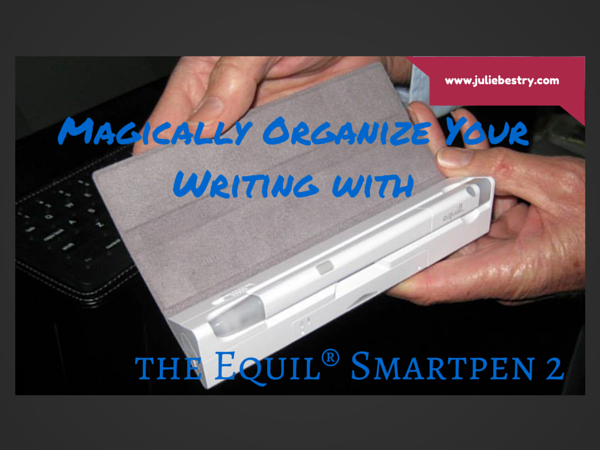
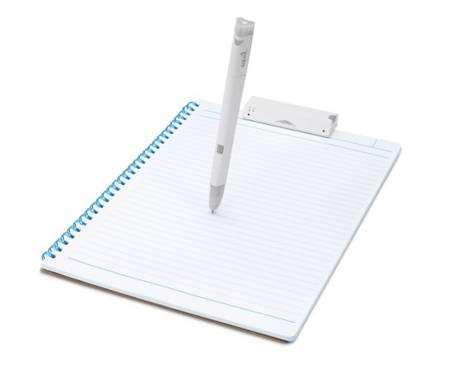
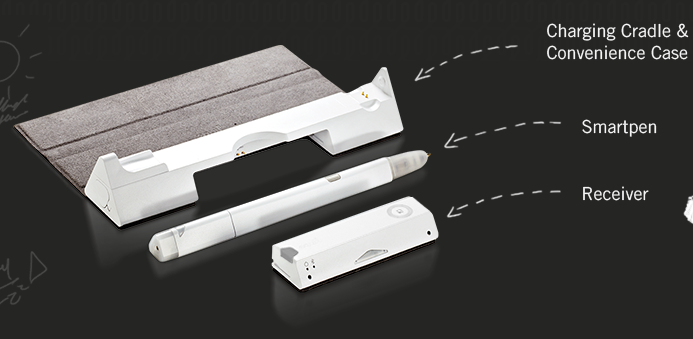


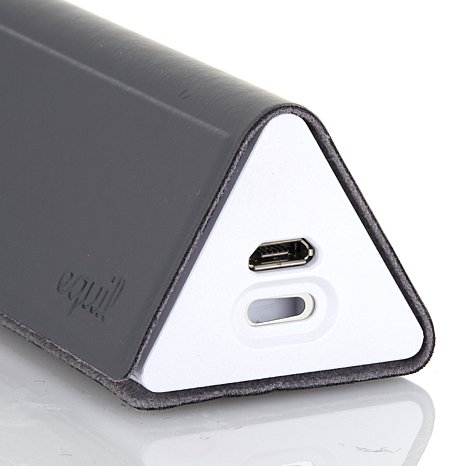
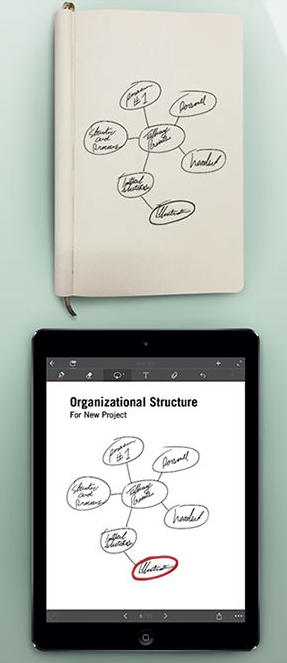
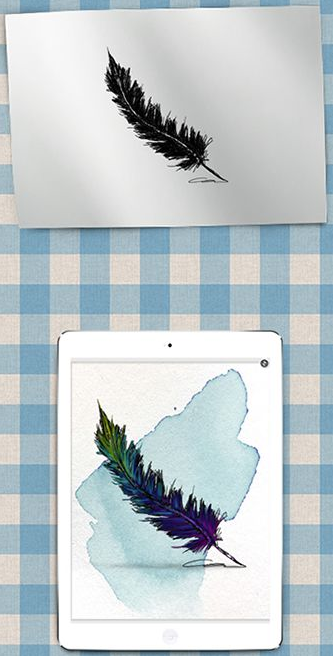


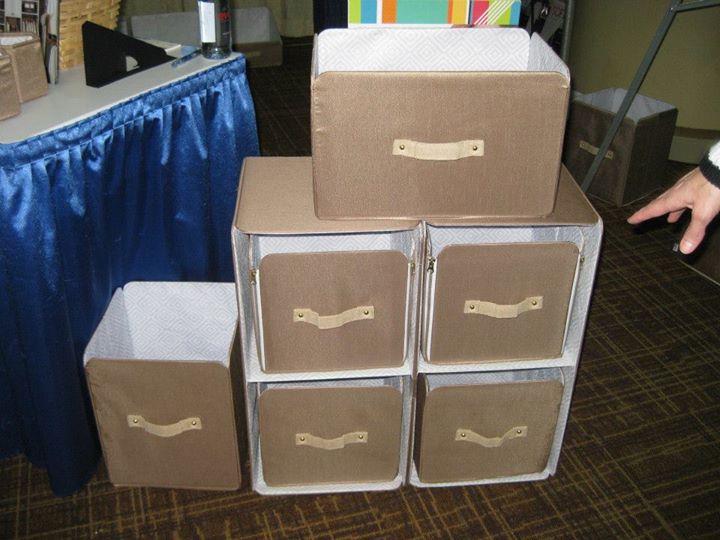
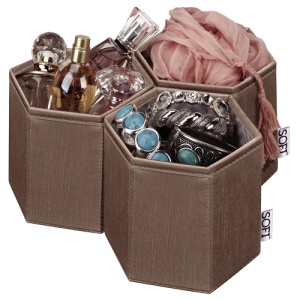
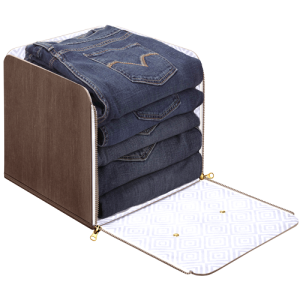
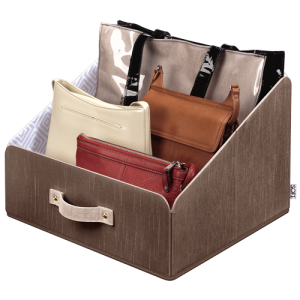
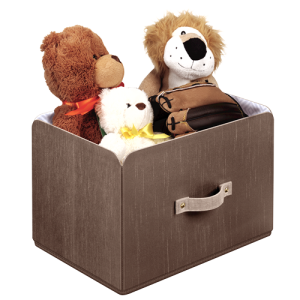
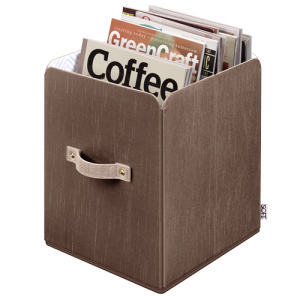
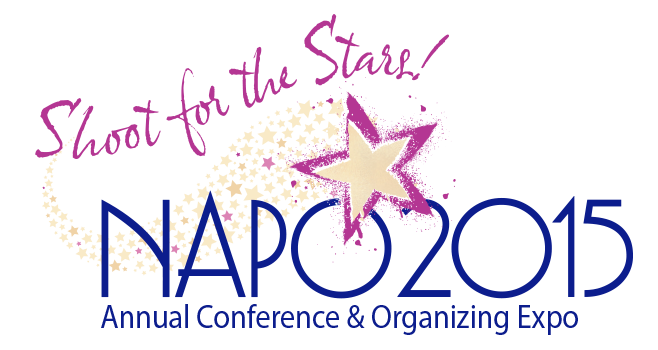

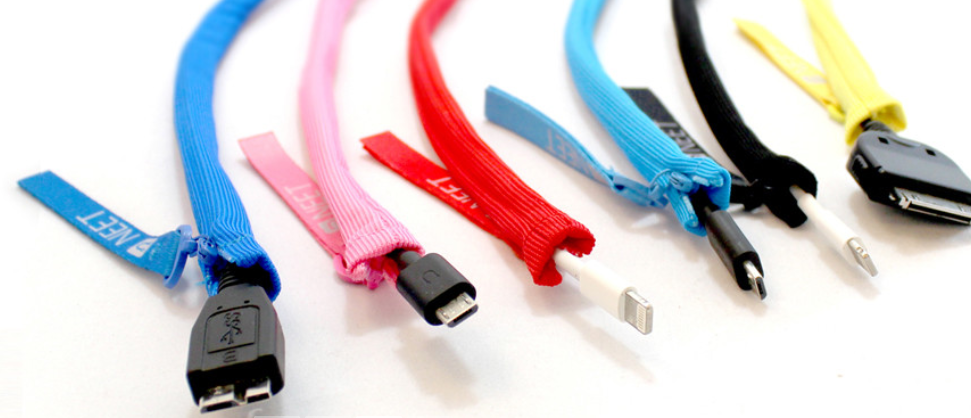

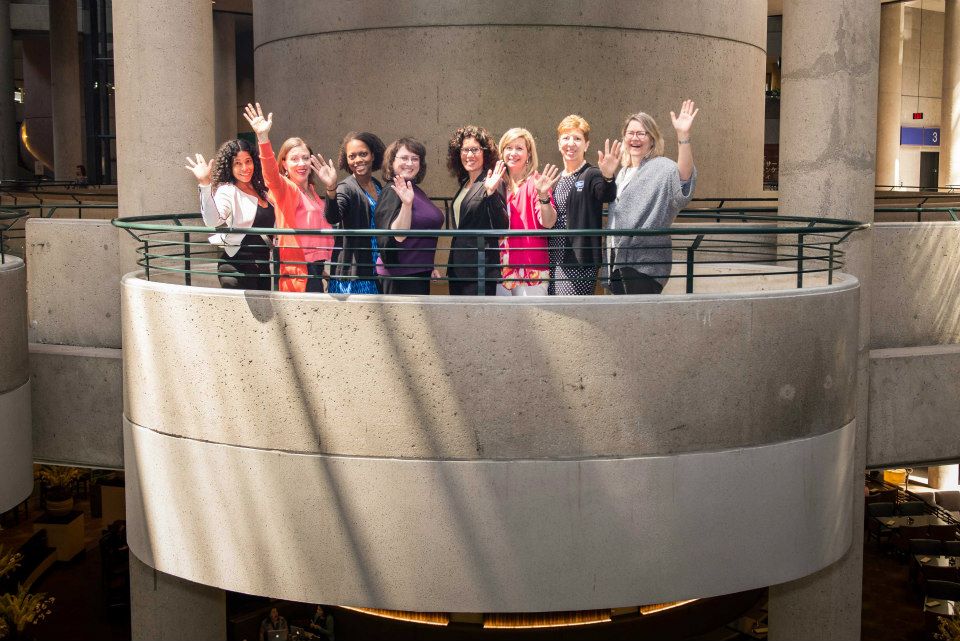
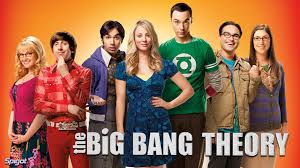
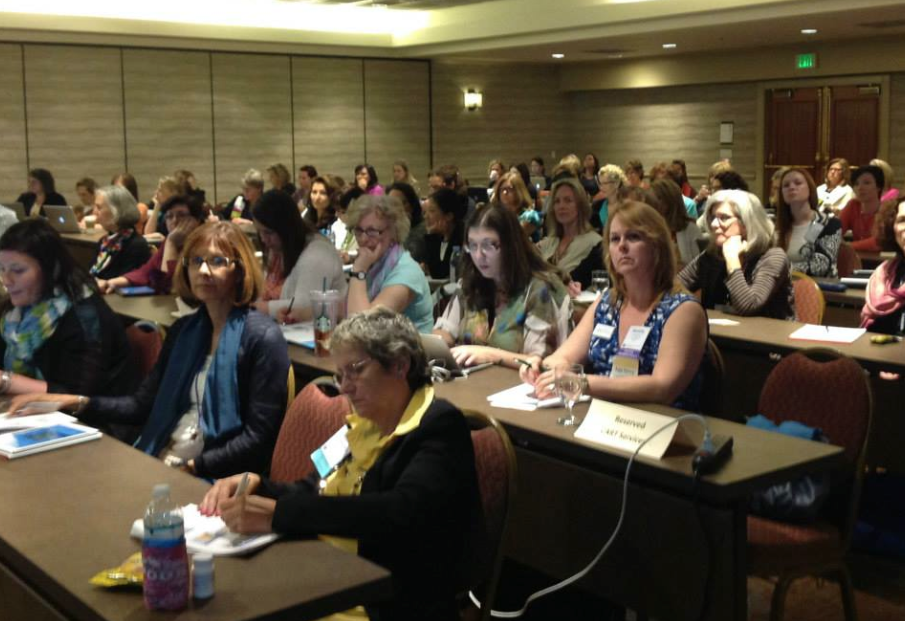
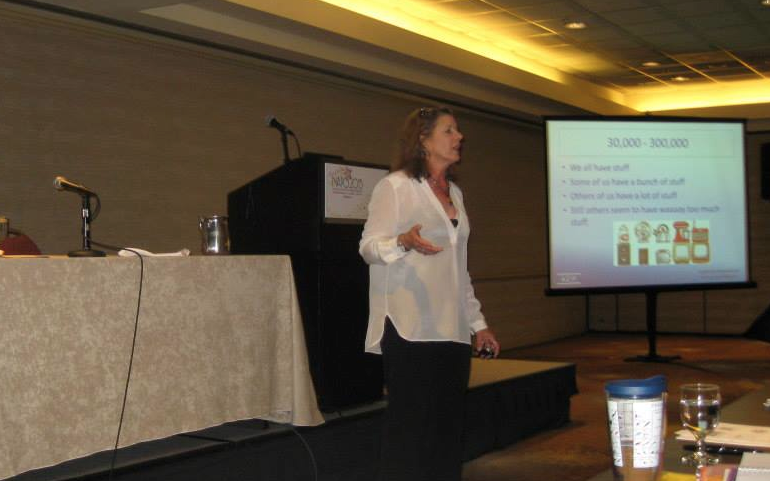


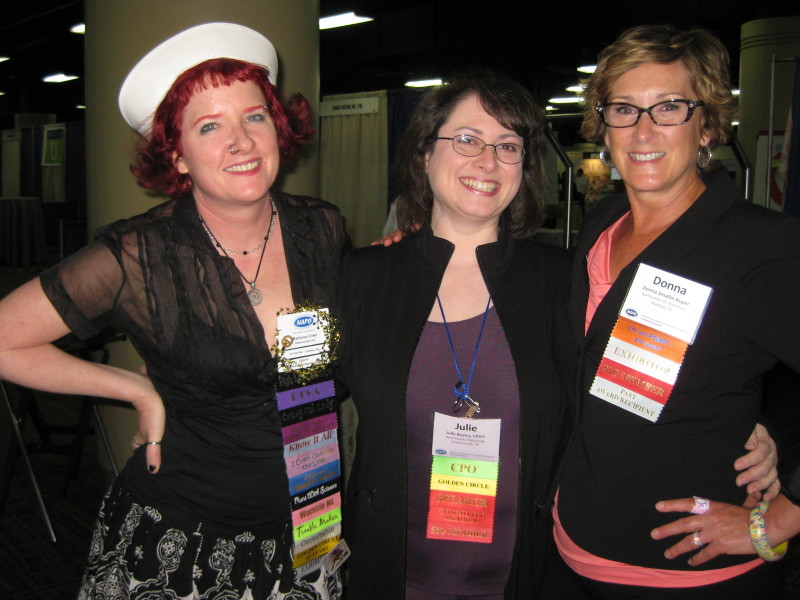
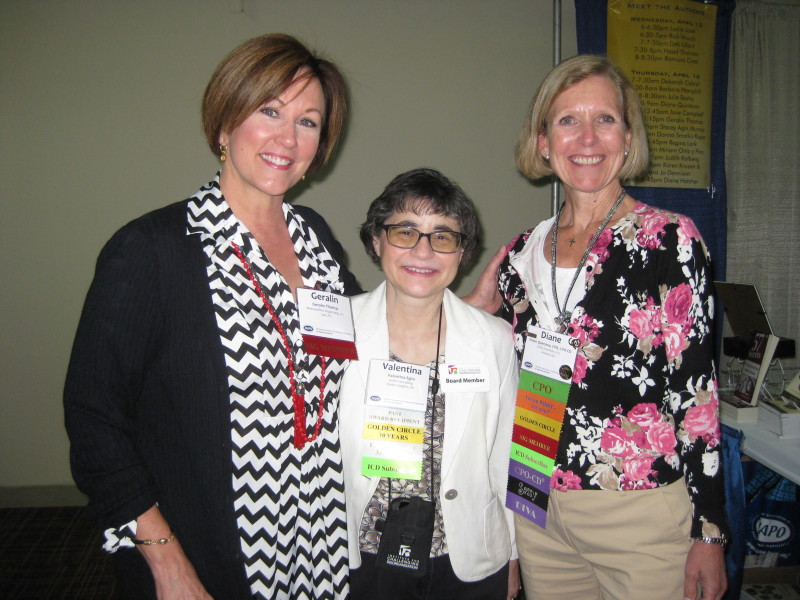
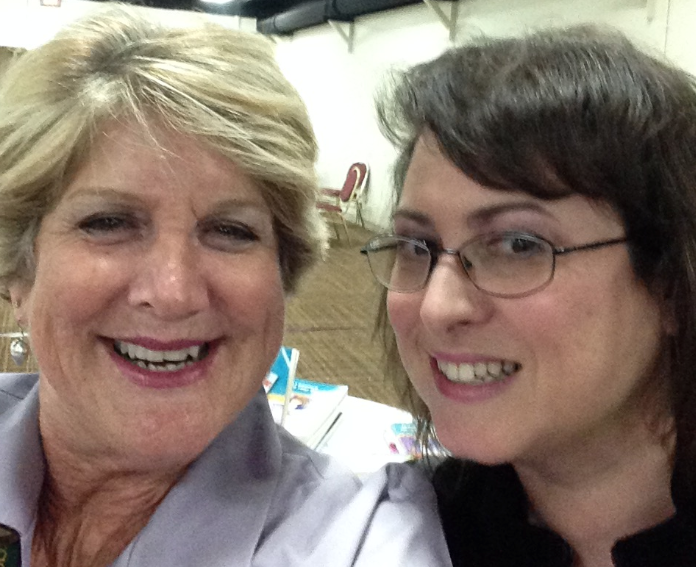
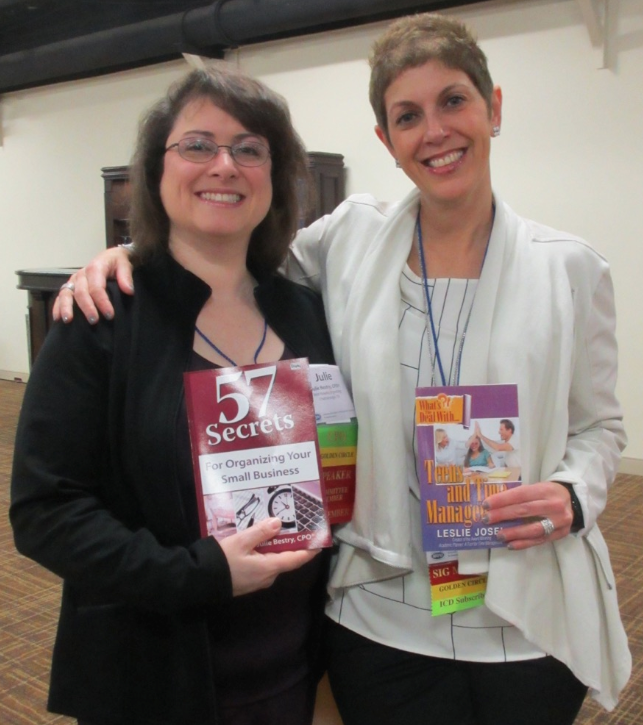



Follow Me